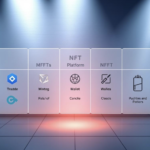Now Reading: Mastering Ethereum Smart Contracts: A Comprehensive Guide
- 01
Mastering Ethereum Smart Contracts: A Comprehensive Guide
Mastering Ethereum Smart Contracts: A Comprehensive Guide

Ethereum smart contracts are a crucial component of blockchain technology, enabling secure and transparent transactions. With the ability to self-execute contracts, Ethereum smart contracts have revolutionized the way we conduct business. By leveraging the power of blockchain technology, individuals and organizations can create efficient and trustworthy transactions.
As we delve into the world of Ethereum smart contracts, it becomes clear that mastering this technology is essential for anyone looking to stay ahead of the curve. Ethereum smart contracts and blockchain technology are intertwined, and understanding their relationship is key to unlocking the full potential of this innovative technology. In this comprehensive guide, we will explore the ins and outs of Ethereum smart contracts, providing a foundation for those looking to harness the power of blockchain technology.
Understanding the Fundamentals of Ethereum Smart Contracts
Ethereum smart contracts are self-executing contracts with the terms of the agreement written directly into lines of code. They enable the creation of decentralized applications that run on the Ethereum network, allowing for secure and transparent transactions. To understand the fundamentals of Ethereum smart contracts, it’s essential to delve into their architecture and role in the ecosystem.
The Ethereum network provides a platform for developers to build and deploy smart contracts, which can be used for a wide range of applications, from simple transactions to complex decentralized finance (DeFi) protocols. The key components of smart contract architecture include the contract code, data storage, and execution environment.
What Are Smart Contracts?
Smart contracts are programs that automate the execution of specific rules or actions when certain conditions are met. They are typically written in a programming language, such as Solidity, and are deployed on the Ethereum network.
The Role of Smart Contracts in the Ethereum Ecosystem
Smart contracts play a crucial role in the Ethereum ecosystem, enabling the creation of decentralized applications that are secure, transparent, and tamper-proof. They allow developers to build complex applications that can interact with the Ethereum network, enabling a wide range of use cases, from gaming to finance.
Key Components of Smart Contract Architecture
The key components of smart contract architecture include:
- Contract code: The programming language used to write the smart contract
- Data storage: The storage of data associated with the smart contract
- Execution environment: The environment in which the smart contract is executed
By understanding the fundamentals of Ethereum smart contracts, developers can build secure, scalable, and decentralized applications that run on the Ethereum network, enabling a wide range of use cases and innovations.
The Evolution of Blockchain-Based Smart Contracts
The Ethereum blockchain has played a significant role in the development of the cryptocurrency ecosystem, with smart contracts being a crucial component. The evolution of blockchain-based smart contracts has been substantial, with a growing focus on security, scalability, and usability. In the Ethereum blockchain, smart contracts have enabled the creation of decentralized applications, allowing for peer-to-peer transactions without the need for intermediaries.
Some key milestones in the evolution of blockchain-based smart contracts include:
- The introduction of the Ethereum blockchain, which enabled the creation of smart contracts
- The development of programming languages such as Solidity, which simplified the process of creating smart contracts
- The growth of decentralized applications, which have utilized smart contracts to enable peer-to-peer transactions
The Ethereum blockchain has been at the forefront of the cryptocurrency ecosystem, with its smart contract functionality enabling a wide range of use cases. As the cryptocurrency ecosystem continues to evolve, it is likely that we will see further innovations in blockchain-based smart contracts, driving increased adoption and usage.
In the cryptocurrency ecosystem, the Ethereum blockchain has set the standard for blockchain-based smart contracts. With its robust functionality and growing community of developers, it is likely that the Ethereum blockchain will continue to play a leading role in the evolution of blockchain-based smart contracts.
| Blockchain Platform | Smart Contract Functionality |
|---|---|
| Ethereum | Decentralized applications, peer-to-peer transactions |
| Bitcoin | Limited smart contract functionality |
| Other platforms | Varying levels of smart contract functionality |
Setting Up Your Development Environment
To start creating and deploying Ethereum smart contracts, it’s essential to set up a development environment. This process involves installing essential tools and software, configuring your workspace, and testing networks and requirements. In the context of digital contracts, a well-structured development environment is crucial for successful smart contract development.
The first step is to install the necessary tools, including a code editor, a Solidity compiler, and a testing framework. Some popular choices for Ethereum smart contract development include Visual Studio Code, Remix, and Truffle. These tools will help you write, compile, and test your smart contracts efficiently, ensuring that your digital contracts are secure and functional.
Essential Tools and Software
- Visual Studio Code: A popular code editor with extensions for Solidity and Ethereum development
- Remix: A web-based Solidity compiler and IDE for Ethereum smart contract development
- Truffle: A testing framework and development environment for Ethereum smart contracts
Once you have installed the necessary tools, you can start configuring your workspace. This involves setting up a new project, creating a contract file, and writing your first smart contract. With a well-structured development environment, you’ll be able to focus on creating and deploying digital contracts that meet your needs, leveraging the power of smart contract development.

Testing Networks and Requirements
Before deploying your smart contracts to the mainnet, it’s essential to test them on a test network, such as Ropsten or Rinkeby. This will help you identify and fix any issues, ensuring that your digital contracts work as intended. By following these steps and using the right tools, you’ll be able to set up a development environment that supports your smart contract development needs, from creating and testing digital contracts to deploying them on the Ethereum network.
Smart Contract Programming Languages
When it comes to developing and deploying smart contracts on the Ethereum platform, the choice of programming language is crucial. Solidity is one of the most popular languages used for Ethereum smart contracts, known for its simplicity and flexibility. Other languages, such as Vyper and Serpent, are also used, each with their own strengths and weaknesses.
The Ethereum platform supports a range of programming languages, allowing developers to choose the one that best suits their needs. Some of the key features to consider when selecting a programming language for Ethereum smart contracts include security, scalability, and ease of use. By choosing the right language, developers can create secure, efficient, and effective smart contracts that meet their specific requirements.
Some of the benefits of using the Ethereum platform for smart contract development include:
- High-level security
- Fast transaction processing
- Large community support
By leveraging these benefits, developers can create innovative and effective smart contracts that meet the needs of their users.
Creating Your First Ethereum Smart Contract
To create a secure Ethereum smart contract, it’s essential to understand the basics of smart contract security and Ethereum smart contracts. This process involves several steps, including defining the contract’s structure and functionality. A well-structured contract is crucial for ensuring the security and integrity of the smart contract.
When creating an Ethereum smart contract, consider the importance of smart contract security and the role of reliable cryptocurrency wallets in protecting your digital assets. Ethereum smart contracts are self-executing contracts with the terms of the agreement written directly into lines of code.
Basic Contract Structure
A basic Ethereum smart contract structure includes variables, functions, and events. Variables are used to store data, while functions are used to perform specific actions. Events are used to notify external contracts or applications of specific occurrences.
Writing Contract Functions
When writing contract functions, consider the security implications of each function. Ensure that each function is designed to prevent potential vulnerabilities, such as reentrancy attacks or front-running attacks. Ethereum smart contracts can be written in programming languages like Solidity.
Deployment Steps
Once the contract is written and tested, it’s ready for deployment. The deployment process involves compiling the contract code, deploying it to the Ethereum network, and verifying the contract’s functionality. By following these steps and prioritizing smart contract security, you can create a secure and reliable Ethereum smart contract.
Advanced Smart Contract Features and Patterns
Advanced smart contract features and patterns are crucial for developing complex decentralized applications on the Ethereum network. These features leverage blockchain technology to create secure, transparent, and efficient applications. Some of the key features include:
Advanced smart contract patterns enable developers to create complex logic and workflows, making it possible to build sophisticated decentralized applications. These patterns include:
- Modular contract design
- Reentrancy protection
- Access control mechanisms
By utilizing these advanced features and patterns, developers can create robust and scalable decentralized applications that take full advantage of blockchain technology. This enables the creation of secure, transparent, and efficient applications that can be used in a variety of industries.
As the use of blockchain technology continues to grow, the demand for advanced smart contract features and patterns will increase. Developers who understand these features and patterns will be well-positioned to create innovative and effective decentralized applications that meet the needs of users.
Testing and Debugging Smart Contracts
Ensuring the security and functionality of smart contracts on the Ethereum network and Ethereum blockchain is crucial. This involves a thorough testing and debugging process. Testing frameworks provide a structured approach to identifying and fixing errors within smart contracts.
When developing smart contracts for the Ethereum blockchain, it’s essential to utilize testing frameworks that can simulate various scenarios, including potential attacks and edge cases. This helps in identifying vulnerabilities early in the development process, thereby enhancing the security of the smart contract on the Ethereum network.
Testing Frameworks
- Truffle: A popular framework for building, testing, and deploying smart contracts on the Ethereum blockchain.
- OpenZeppelin: Provides a set of tools and libraries for developing secure smart contracts, including testing frameworks.
Common debugging techniques involve systematically checking the code for logical errors, using tools to identify gas inefficiencies, and testing the contract’s behavior under different conditions on the Ethereum network. Automated testing strategies can significantly reduce the time and effort required for testing, making it possible to deploy secure and functional smart contracts on the Ethereum blockchain more efficiently.
Smart Contract Security Best Practices
Securing smart contracts is crucial for protecting the cryptocurrency ecosystem and ensuring the integrity of digital contracts. As the use of smart contracts continues to grow, it’s essential to implement security best practices to prevent vulnerabilities and attacks.
In the context of Ethereum smart contracts, security is a top priority. A single vulnerability can compromise the entire cryptocurrency ecosystem, leading to significant financial losses. Therefore, it’s essential to understand common vulnerabilities, security auditing processes, and prevention strategies.
Common Vulnerabilities
- Reentrancy attacks
- Front-running attacks
- Denial-of-Service (DoS) attacks
Security Auditing Process
A thorough security audit is essential to identify vulnerabilities in smart contracts. This process involves reviewing the contract code, testing for vulnerabilities, and identifying potential entry points for attacks.
Prevention Strategies
To prevent attacks, it’s essential to implement security best practices, such as using secure coding practices, testing thoroughly, and implementing access controls. By following these strategies, developers can ensure the security and integrity of their digital contracts and protect the cryptocurrency ecosystem.
By prioritizing smart contract security, developers can build trust in the cryptocurrency ecosystem and ensure the long-term success of their digital contracts.
| Vulnerability | Description | Prevention Strategy |
|---|---|---|
| Reentrancy attacks | Attackers exploit contract functions to drain funds | Use secure coding practices, such as reentrancy locks |
| Front-running attacks | Attackers manipulate transaction order to gain an advantage | Implement access controls, such as rate limiting |
Gas Optimization Techniques
Optimizing gas usage is crucial for reducing the cost of deploying and executing Ethereum smart contracts on the Ethereum platform. In smart contract development, gas optimization techniques play a significant role in ensuring efficient execution and minimizing costs. One approach to achieve this is by using efficient data storage and computation methods.
Some key strategies for gas optimization in smart contract development on the Ethereum platform include:
- Minimizing the number of transactions
- Using efficient data types and storage solutions
- Optimizing contract logic and computation
These techniques can help reduce gas consumption, making smart contract development more cost-effective and efficient on the Ethereum platform.

By implementing these gas optimization techniques, developers can create more efficient and cost-effective smart contracts, which is essential for the widespread adoption of the Ethereum platform. As the demand for smart contract development continues to grow, the importance of gas optimization will only continue to increase, driving innovation and improvement in this area.
Integrating Smart Contracts with Web Applications
Integrating Ethereum smart contracts with web applications is a crucial step in leveraging the power of blockchain technology. To achieve this, it is essential to consider smart contract security and the Ethereum smart contract development process. A well-designed integration can provide a seamless user experience, while also ensuring the security and integrity of the smart contract.
When integrating smart contracts with web applications, several factors come into play. These include the choice of programming language, the development framework, and the user interface. By carefully considering these factors, developers can create a robust and user-friendly application that showcases the benefits of Ethereum smart contracts.
Web3.js Implementation
One popular approach to integrating smart contracts with web applications is to use Web3.js, a JavaScript library that provides a simple and intuitive interface for interacting with the Ethereum blockchain. With Web3.js, developers can easily deploy and manage smart contracts, as well as handle user interactions and data storage.
Frontend Integration Strategies
When it comes to frontend integration, there are several strategies to consider. These include using a web framework such as React or Angular, and leveraging libraries such as Ethers.js or Web3.js to handle smart contract interactions. By choosing the right tools and technologies, developers can create a seamless and intuitive user experience that showcases the benefits of Ethereum smart contracts.
User Interface Considerations
When designing the user interface for a web application that integrates with Ethereum smart contracts, there are several key considerations to keep in mind. These include providing clear and concise instructions, handling errors and exceptions, and ensuring that the user experience is intuitive and user-friendly. By carefully considering these factors, developers can create a robust and engaging application that showcases the benefits of smart contract security and Ethereum smart contracts.
| Integration Strategy | Description |
|---|---|
| Web3.js | A JavaScript library for interacting with the Ethereum blockchain |
| Ethers.js | A library for handling smart contract interactions and data storage |
Real-World Implementation Cases
Ethereum smart contracts have numerous real-world applications, demonstrating the potential of blockchain technology in the cryptocurrency ecosystem. These applications include supply chain management, voting systems, and other industries. The use of smart contracts in these areas highlights the benefits and challenges of using blockchain technology.
Some notable examples of real-world implementation cases include:
- Supply chain management: Companies like Maersk and Walmart are using Ethereum smart contracts to track and verify the origin and movement of goods.
- Voting systems: Countries like Estonia are using blockchain technology to create secure and transparent voting systems.
- Insurance: Companies like AXA are using smart contracts to automate insurance claims and payouts.
These examples demonstrate the versatility and potential of Ethereum smart contracts in various industries. As the cryptocurrency ecosystem continues to evolve, we can expect to see even more innovative applications of blockchain technology.
The use of Ethereum smart contracts in real-world applications has the potential to increase efficiency, transparency, and security. As the technology continues to mature, we can expect to see widespread adoption across various industries, further solidifying the importance of blockchain technology in the cryptocurrency ecosystem.
| Industry | Application | Benefits |
|---|---|---|
| Supply Chain Management | Tracking and verification | Increased efficiency and transparency |
| Voting Systems | Secure and transparent voting | Increased security and trust |
| Insurance | Automated claims and payouts | Increased efficiency and reduced costs |
Regulatory Compliance and Legal Considerations
When developing decentralized applications on the Ethereum network, it is essential to consider regulatory compliance and legal considerations. This includes understanding the legal framework that governs the development and deployment of decentralized applications.
The legal framework for decentralized applications is still evolving, but it is crucial to ensure compliance with existing regulations. This can be achieved by conducting thorough research and consulting with legal experts to ensure that the application meets all necessary requirements.
Compliance Requirements
Compliance requirements for decentralized applications on the Ethereum network include:
- Adhering to anti-money laundering (AML) and know-your-customer (KYC) regulations
- Complying with securities laws and regulations
- Ensuring data protection and privacy
Documentation Standards
Documentation standards are also crucial for ensuring regulatory compliance and legal considerations. This includes maintaining accurate and transparent records of the application’s development, deployment, and maintenance.

By prioritizing regulatory compliance and legal considerations, developers can ensure that their decentralized applications are built on a solid foundation and are more likely to succeed in the long term.
| Regulatory Requirement | Description |
|---|---|
| AML/KYC | Anti-money laundering and know-your-customer regulations |
| Securities Laws | Compliance with securities laws and regulations |
| Data Protection | Ensuring data protection and privacy |
Embracing the Future of Smart Contract Development
As the Ethereum blockchain and platform continue to evolve, the future of smart contract development holds immense potential. Developers and businesses must stay at the forefront of this rapidly changing landscape to fully leverage the benefits of Ethereum smart contracts. From streamlining complex business processes to enabling secure and transparent transactions, the applications of this transformative technology are vast and far-reaching.
With a deep understanding of the Ethereum ecosystem, innovators can unlock new possibilities and create groundbreaking solutions that address the needs of diverse industries. By embracing the future of smart contract development, we can pave the way for a more efficient, transparent, and decentralized future, where smart contracts become the backbone of a wide range of digital interactions and transactions.
FAQ
What are Ethereum smart contracts?
Ethereum smart contracts are self-executing contracts with the terms of the agreement written directly into lines of code. They are an integral part of the Ethereum blockchain, enabling secure and transparent transactions in the cryptocurrency ecosystem.
What is the role of smart contracts in the Ethereum ecosystem?
Smart contracts play a crucial role in the Ethereum ecosystem by enabling the development of decentralized applications (dApps) that run on the Ethereum network. They allow for the creation of digital contracts that automatically execute when predetermined conditions are met, without the need for intermediaries.
What are the key components of smart contract architecture?
The key components of smart contract architecture include the contract code, which defines the terms and conditions of the agreement; the contract state, which stores the current state of the contract; and the contract functions, which allow for the interaction and manipulation of the contract state.
How has the evolution of blockchain-based smart contracts impacted the cryptocurrency ecosystem?
The evolution of blockchain-based smart contracts, particularly the development of the Ethereum blockchain, has had a significant impact on the cryptocurrency ecosystem. Ethereum smart contracts have enabled the creation of a wide range of decentralized applications, revolutionizing the way transactions and digital contracts are processed and executed.
What are the essential tools and software required for setting up an Ethereum smart contract development environment?
The essential tools and software for setting up an Ethereum smart contract development environment include Ethereum client software (such as Geth or Parity), a code editor (such as Visual Studio Code or Remix), and development frameworks (such as Truffle or Hardhat). Configuring the workspace and testing networks are also crucial steps in the setup process.
What programming languages are used for Ethereum smart contract development?
The primary programming language used for Ethereum smart contract development is Solidity, a contract-oriented, high-level language that is designed to be used for implementing smart contracts. Solidity is specifically tailored for the Ethereum platform and allows developers to create and deploy secure and reliable smart contracts.
How can I create and deploy my first Ethereum smart contract?
To create and deploy your first Ethereum smart contract, you’ll need to understand the basic contract structure, write the contract functions, and follow the deployment steps. This process typically involves compiling the contract code, deploying it to the Ethereum network, and interacting with the deployed contract through a wallet or application interface.
What are some advanced smart contract features and patterns?
Advanced smart contract features and patterns include the use of blockchain technology for secure and transparent transactions, the implementation of complex business logic and conditional execution, and the integration of external data sources and off-chain computations. These features enable the development of more sophisticated decentralized applications on the Ethereum network.
How can I effectively test and debug Ethereum smart contracts?
Effective testing and debugging of Ethereum smart contracts involves the use of testing frameworks, such as Truffle or Hardhat, which provide tools for unit testing, integration testing, and automated testing. Common debugging techniques include code inspection, logging, and the use of debuggers like Remix or Ganache.
What are the best practices for ensuring Ethereum smart contract security?
Best practices for ensuring Ethereum smart contract security include identifying and mitigating common vulnerabilities, such as reentrancy attacks and integer overflow/underflow issues, conducting regular security audits, and implementing prevention strategies like input validation, access control, and secure storage of sensitive data.
How can I optimize gas usage for my Ethereum smart contracts?
Gas optimization techniques for Ethereum smart contracts include using efficient data storage and computation, minimizing the number of contract function calls, optimizing contract code, and leveraging gas-efficient programming patterns. These techniques can help reduce the cost of deploying and executing smart contracts on the Ethereum platform.
How can I integrate Ethereum smart contracts with web applications?
Integrating Ethereum smart contracts with web applications typically involves using a library like Web3.js to interact with the Ethereum blockchain from the frontend. This includes implementing contract interaction, handling user transactions, and designing a user-friendly interface that seamlessly connects the web application with the smart contract functionality.
What are some real-world implementation cases of Ethereum smart contracts?
Ethereum smart contracts have been implemented in a variety of real-world use cases, including supply chain management, voting systems, digital identity management, and decentralized finance (DeFi) applications. These use cases demonstrate the versatility and potential of blockchain technology in transforming traditional processes and enabling new business models.
What are the regulatory compliance and legal considerations for Ethereum smart contracts?
Regulatory compliance and legal considerations for Ethereum smart contracts include establishing a clear legal framework, ensuring compliance with relevant laws and regulations (such as data privacy, anti-money laundering, and consumer protection laws), and adhering to documentation standards for the development and deployment of decentralized applications.
What is the future of smart contract development?
The future of smart contract development is promising, with ongoing advancements in the Ethereum blockchain and the Ethereum platform. Continued innovation in areas such as scalability, interoperability, and security will likely lead to the wider adoption of Ethereum smart contracts and the expansion of their applications in the cryptocurrency ecosystem and beyond.















